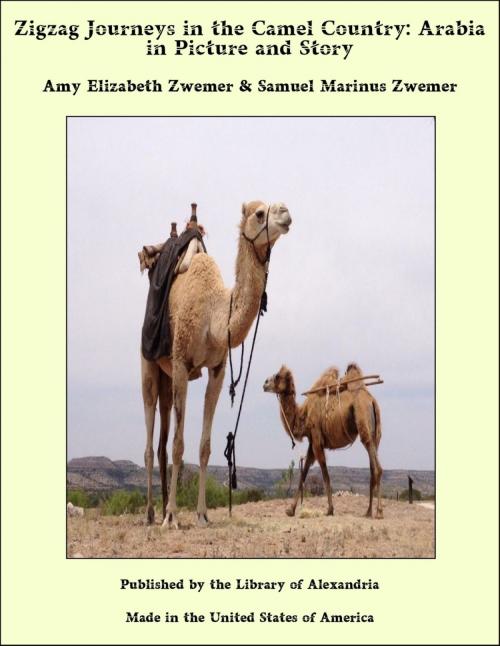Zigzag Journeys in the Camel Country: Arabia in Picture and Story
Nonfiction, Religion & Spirituality, New Age, History, Fiction & Literature| Author: | Amy Elizabeth Zwemer and Samuel Marinus Zwemer | ISBN: | 9781465626721 |
| Publisher: | Library of Alexandria | Publication: | March 8, 2015 |
| Imprint: | Language: | English |
| Author: | Amy Elizabeth Zwemer and Samuel Marinus Zwemer |
| ISBN: | 9781465626721 |
| Publisher: | Library of Alexandria |
| Publication: | March 8, 2015 |
| Imprint: | |
| Language: | English |
Zigzag are the lines across the deserts of Arabia that mark the weary journeys of the camel caravans for centuries. Arabia has no straight roads. The crooked, winding paths through valley and along mountainside or over sandy tracks are worn smooth by the shuffling feet of the animal-with-the-long-neck. Every bit of desert thorn or green herb on either side of the path means a step away from the straight line. The caravan zigzags towards its destination. The ship of the desert makes more tacks in its onward course than a sailing-boat with a contrary wind in a narrow harbour. The Arab, like the camel, is not in love with straight lines. An Arab carpenter cannot draw a right angle, and the Arab mason seldom uses a plummet. An Arab servant has great trouble in laying a table-cloth square on the table. The old Arab temple at Mecca is called “a Cube” (Kaaba), and yet has none of its sides and angles equal but is a zigzag building. Streets are never parallel or at right angles, but go crisscross in all sorts of ways except the shortest way. And so it came to pass that when the tribes of men after the deluge scattered from the Tower of Babel far to the south of the big Arabian peninsula they too travelled in zigzag lines. Some went to the far east on the Persian Gulf and began to be pearl-divers at Bahrein. Others took their best camels all the way across the waterless desert of the interior and settled in Oman to become the breeders of the finest dromedaries. Others went meandering southward along the river-beds, called wadies, till they came to the beautiful mountains of Yemen, green with trees and bright with blossoms. Others loved the dry, clear, keen air of the high plateau, and making tents of goat-hair they lived with their flocks, and are the Bedouin tribes of to-day. Still others were driven to the west and, because the country was barren and dreadfully hot, settled near a spring called Zem Zem, and built the city of Mecca. The waters of the spring were good, they said, for fever and pain, and so Mecca became a health resort and a market-place, and finally a religions centre. Every year the distant tribes came in great caravans to visit the city and exchange mares, camel-foals and bits of poetry.
Zigzag are the lines across the deserts of Arabia that mark the weary journeys of the camel caravans for centuries. Arabia has no straight roads. The crooked, winding paths through valley and along mountainside or over sandy tracks are worn smooth by the shuffling feet of the animal-with-the-long-neck. Every bit of desert thorn or green herb on either side of the path means a step away from the straight line. The caravan zigzags towards its destination. The ship of the desert makes more tacks in its onward course than a sailing-boat with a contrary wind in a narrow harbour. The Arab, like the camel, is not in love with straight lines. An Arab carpenter cannot draw a right angle, and the Arab mason seldom uses a plummet. An Arab servant has great trouble in laying a table-cloth square on the table. The old Arab temple at Mecca is called “a Cube” (Kaaba), and yet has none of its sides and angles equal but is a zigzag building. Streets are never parallel or at right angles, but go crisscross in all sorts of ways except the shortest way. And so it came to pass that when the tribes of men after the deluge scattered from the Tower of Babel far to the south of the big Arabian peninsula they too travelled in zigzag lines. Some went to the far east on the Persian Gulf and began to be pearl-divers at Bahrein. Others took their best camels all the way across the waterless desert of the interior and settled in Oman to become the breeders of the finest dromedaries. Others went meandering southward along the river-beds, called wadies, till they came to the beautiful mountains of Yemen, green with trees and bright with blossoms. Others loved the dry, clear, keen air of the high plateau, and making tents of goat-hair they lived with their flocks, and are the Bedouin tribes of to-day. Still others were driven to the west and, because the country was barren and dreadfully hot, settled near a spring called Zem Zem, and built the city of Mecca. The waters of the spring were good, they said, for fever and pain, and so Mecca became a health resort and a market-place, and finally a religions centre. Every year the distant tribes came in great caravans to visit the city and exchange mares, camel-foals and bits of poetry.















